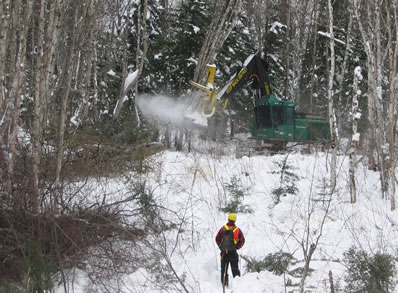Riparian areas
Maintaining biodiversity in riparian areas
Forests provide many ecosystem goods and services that we depend on, including not only forest products like lumber and paper, but also fresh water and the biodiversity in and around forest water bodies. Scientists and forest managers are continually attempting to improve forest management practices to both maintain the supply of forest products and conserve the other ecosystem goods and services that that forests provide.
Forest ecologists now know that one of the best ways to maintain forest ecosystem integrity is to manage forest harvest in a way that emulates nature. In nature, periodic disturbances by natural events like fire, insect infestations, and blow-down are necessary for sustaining healthy forest ecosystems. Natural disturbances create a range of forest conditions on the landscape, and that complexity provides important habitat for a variety of plants and animals, thereby supporting biodiversity.
Forest managers are increasingly using harvesting patterns and schedules to mimic natural disturbance patterns and to create similar complexity in managed forest landscapes.

Forest harvesting in a riparian area to emulate natural shoreline disturbance patterns in the boreal forest of northern Ontario.
Until recently, however, this approach has not been used around forest water bodies. The conventional approach to protecting water resources is to retain riparian (shoreline) buffers or reserves around most water bodies. However, it is becoming clear that uninterrupted riparian buffers are creating unnatural forest patterns across managed landscapes and, consequently, do not provide the habitat complexity that would result from natural disturbances and renewal.
Canadian Forest Service researchers, in collaboration with the Ontario Ministry of Natural Resources, several university partners, and the forest industry, have been comparing natural disturbances in shoreline areas of forest water bodies to disturbances from forest harvesting. These disturbances not only create increased shoreline habitat complexity, but they also cause changes in the water bodies themselves that are important for sustaining aquatic ecosystem health. The research has shown that careful shoreline harvesting can be conducted in some areas to increase shoreline habitat complexity and minimize harmful effects in water bodies.
New forest management regulations in Ontario and elsewhere across Canada are beginning to allow, or even encourage, some degree of forest harvesting closer to water than the conventional riparian buffers allowed. Ongoing research will be looking at when and where to use intentional shoreline harvesting, and to ensure that the effects of shoreline harvesting will in fact emulate natural disturbance effects while still adequately protecting water resources and aquatic habitats.
- Dave Kreutzweiser
- Introduction and a theoretical basis for using disturbance by forest management activities to sustain aquatic ecosystems (2012)
- Emulation of natural disturbance (END) for riparian forest management: synthesis and recommendations (2012)
- Forest management practices based on emulation of natural disturbances (END): implications for aquatic ecosystems (2012)
- More research
Page details
- Date modified: